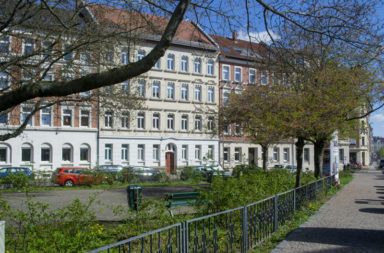Around 1000 founding of Lindenau
1486 first mention of Plagwitz
1834/35 the village counts 998 inhabitants in Lindenau, Plagwitz has 172 inhabitants
1854 Karl Heine begins purchasing land for the construction of industrial enterprises
1856 construction of today’s Karl-Heine Canal, which was to connect the White Elster with the Saale
Around 1860 the Lindenau village pond is filled-in, on its surface the Lindenau Market is built
1873 Plagwitz obtains railway connection from the direction of Zeitz
1881 opening of the horse tram Leipzig – Lindenau (from 1896 electric)
1888 the company founded by Hermann Julius Meyer “Verein zur Erbauung billiger Wohnungen” (Association for the Edification of Cheap Habitation ) begins with the construction of the current “Meyer’s houses” between Henrici- and Hahnemann road
1890/91 incorporation into the city of Leipzig. At this time, Plagwitz counts some 13,000 inhabitants, Lindenau nearly 26,000. Both districts are heavily influenced by industrialization: there are 66 larger companies with more than 3,000 employees in Lindenau and in Plagwitz over 100 factories with about 6,000 jobs. Leisure facilities also arise with Charlottenhof and Felsenkeller with a beer garden (1890) and Palm Garden (1899).
1925 Lindenau achieves its highest population density with almost 63,000 inhabitants
1938 construction of the Lindenau harbor; 1943: the work on the channel and harbour is cancelled
1954-58 with the construction of the Hermann-Duncker settlement in Neulindenau, the first major modern development area of the post-war period in Leipzig arises
1969 opening of the Leipzig city train (S-Bahn) with stops in Lindenau and Plagwitz
1980s large parts of Plagwitz lie empty – cultural institutions close and at the same time there is an increase in the perception of environmental damage, the district has a strong negative image
1989 at the time of reunification there are at least 20,000 jobs in Plagwitz and a number of large, specialized companies in the metal and textile industry
1990-92 collapse of the industry; first decision of the urban planning committee towards a “careful urban redevelopment”, which maintains the tradition of the district
1992-94 water restoration of the Karl-Heine-Canal and construction of parallel paths
1998 Plagwitz is an official project of EXPO 2000 under the title “Plagwitz on the way into the 21st century – an example of sustainable urban redevelopment”
2000 the converted Lindenau market is opened to the public, the city park of Plagwitz on the site of a former railway loading point is completed.
2013 the transformation of the former freight-train depot Plagwitz into public green space begins


